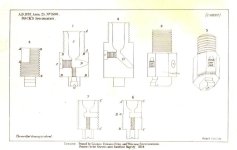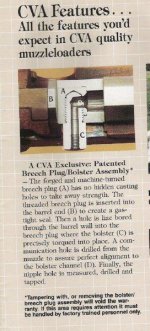I found the schematics of the breech of each of the Enfield rifles in question. Neither diagram illustrates the internal breech design. They only show that the breech of the Armisport is made from one piece (without a separate breech plug) while the breech of the Euroarms is made of two pieces which includes a separate breech plug.
Whether the Armisport is truly a patent breech design with a distict powder chamber is anybody's best guess unless they are familar with its actual internal design.
However, the patent breech has become a very generic label and very often simply refers to having a separate piece at the barrel breech that contains the bolster or snail and nipple.
In other words, both guns just might only have a simple flash hole that leads to the main powder charge and not into a separate powder chamber. But because the Armisport has a one piece unitary breech plug, it's being referred to as a patent breech simply because it looks like one. While the separate breech plug of the Euroarms does seem to indicate that it isn't a patent breech at all but certainly resembles what most folks would commonly call a patent breech if only by looking at its exterior.
I don't think that it really matters very much at all because they're not flintlocks, the musket nipple provides a hotter flash than a percussion cap does, and the caliber is so large that the powder load would burn just about as fast as a true patent breech ignition anyway.
It might even be arguable that the patent breech isn't always better, especially if very coarse cannon powder or such was being loaded. I mean who really knows what the performance really is?
Not too many people shoot cannon powder in their Enfields, but even if they did I don't really see how a patent breech would make much if any ignition difference with modern powder. Then there's the issue of which is the more original design, that is if there is any internal difference between them at all. At some point in the future, some Euroarms Enfield buyers just might appreciate having a removable breech plug if they ever want to get inside their barrel without needing to remove & replace an entire one piece barrel breech and lining it up properly. Just stating that for the sake of argument anyway.

The Armisport schematic is located on page 41 of this PDF manual:
http://www.armisport.com/manuali/blackpowder.pdf
Then 1853 Euroarms schematic is located on page 3 of this PDF manual, and the Euroarms 1858 breech looks the same:
http://www.euroarms.net/Avancarica/esplosi/EXPL_VIEW_ENF_3B_1853.pdf

